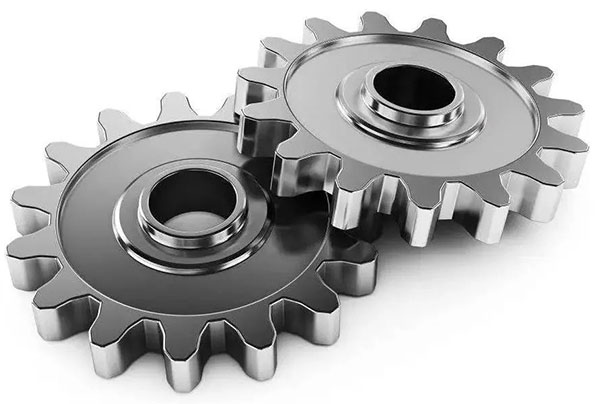Part 1: Gears and shaft parts
1.Gear machining process
According to different structural requirements, the main technological process of gear parts processing adopts forging blank→normalizing→finishing machining→gear shaping→chamfering→hobbing→gear shaving→(welding)→heat treatment→grinding→pairing trimming .
Generally, the teeth are no longer processed after heating, except for the main-minus-slave teeth or the parts that customers require to be ground. Forging processing is one of Sunbright's metal processing advantages. You can also learn about some of our auto parts on gear processing parts such as precision forging automotive parts.

Input shaft: forging blank→normalizing→finishing turning→gear rolling→drilling→gear shaping→chamfering→gear hobbing→gear shaving→heat treatment→grinding→grinding.
Output shaft: forging blank→normalizing→finishing machining→gear rolling and hobbing→gear shaving→heat treatment→grinding→pairing and trimming.
3.Specific process flow
(1) Forging billet
Hot die forging is a widely used blank forging process for automotive gear parts. In the past, hot forged and cold extruded blanks were widely used. In recent years, cross wedge rolling technology has been widely promoted in shaft processing. This technology is particularly suitable for making blanks for more complex stepped shafts. It not only has high precision, small subsequent machining allowances and high production efficiency.
(2) Normalizing
The purpose of this process is to obtain the hardness suitable for subsequent gear cutting and prepare the organization for the final heat treatment, so as to effectively reduce the heat treatment deformation. General normalizing is greatly affected by personnel, equipment and environment, making it difficult to control the cooling rate and uniformity of the workpiece, resulting in large hardness dispersion and uneven metallographic structure, which directly affects machining and final heat treatment.
(3) Finish turning processing
In order to meet the positioning requirements of high-precision gear processing, the precision turning of the gear blanks all use CNC lathes. The inner hole and the positioning end face of the gear are processed first, and then the other end face and outer diameter are processed simultaneously. This not only guarantees the verticality requirements of the inner hole and the positioning end surface, but also ensures that the size dispersion of the mass production of tooth blanks is small. Thereby, the precision of the gear blank is improved and the processing quality of the subsequent gears is ensured.
The positioning datum and clamping for shaft parts processing mainly have the following three methods:
1.Positioning by the center hole of the workpiece: In the processing of the shaft, the coaxiality of the outer circular surface and the end surface of the part, and the perpendicularity of the end face to the axis of rotation are the main items of their mutual position accuracy. The design basis of these surfaces is generally If the center line of the shaft is positioned with two center holes, it conforms to the principle of coincidence of the datum.
2.The outer circle and the center hole are used as the positioning reference (one clamp and one top): Although the centering accuracy is high with two center holes, the rigidity is poor, especially when processing heavier workpieces, it is not stable enough, and the cutting amount cannot be too large. In rough machining, in order to improve the rigidity of the part, the outer surface of the shaft and a center hole can be used as a positioning reference for machining. This positioning method can withstand larger cutting moments and is the most common positioning method for shaft parts.
3.Use two outer circular surfaces as positioning reference: When processing the inner hole of a hollow shaft, (for example: the inner hole processing with Morse taper on a machine tool), the center hole cannot be used as the positioning reference, and the two outer circular surfaces of the shaft can be used as the positioning reference . When the workpiece is a machine tool spindle, the two supporting journals (assembly datum) are often used as the positioning datum to ensure the coaxiality requirements of the tapered hole relative to the supporting journal and eliminate errors caused by the datum misalignment.
1. Process
The general process flow is milling the bonding surface → machining process holes and connecting holes → rough boring bearing holes → fine boring bearing holes and positioning pin holes → cleaning → leak test detection.
2.Control method
(1)Fixture
The machining process of the transmission housing takes "vertical machining center machining. 10# process + vertical machining center machining 20# process + horizontal machining center machining 30# process" as an example. Three sets of machining center fixtures are required to avoid workpieces. For the clamping deformation, factors such as tool interference, flexible operation, multiple pieces and one clamping, and fast switching must also be considered.
(2) Tool aspect
In the manufacturing cost of auto parts, tool costs account for 3% to 5% of the total cost. The modular structure of the composite tool has the characteristics of high accuracy, reusable tool holder and low inventory, and is widely used. It can greatly shorten the processing time and improve labor efficiency. Therefore, when the accuracy requirements are not high and the standard tools can achieve better processing results, try to use standard tools to reduce inventory and improve interchangeability. At the same time, for mass-produced parts, the use of advanced non-standard composite tools for parts with high precision requirements can further improve processing accuracy and production efficiency.
(Source: Automobile Technologist, Machining Xiaozhuge)
-------------------------------------------------END-----------------------------------------------
Edit By Rebecca Wang

